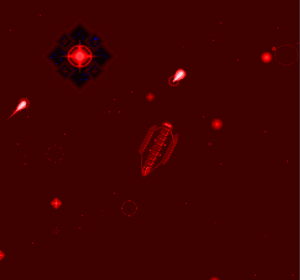HyperSpace
HyperSpace is a "higher dimension" or set of dimensions that forms an alternate space-time to TrueSpace. Basic physical constants are different in HyperSpace than TrueSpace, but modern technology allows spacefaring civilizations to use HyperSpace as a medium for communication (Hyperwave) and transport (Hyperdrive).
All of known HyperSpace is permeated by a dense physical medium that emits radiation ranging into the red levels of the visible spectrum, a much denser, higher-energy analogue to the interstellar hydrogen medium and cosmic background radiation that permeate TrueSpace. Random interactions within this medium create patterns of radiation flares and nebulous structures, but these are ephemeral and unpredictable. Under certain conditions strong TrueSpace gravity wells create intrusions into HyperSpace, regions of overlap with TrueSpace detectable as regions of nonradiating black vacuum from HyperSpace.
Hyperdrive ships operate by artificially generating such overlaps in TrueSpace, allowing ships to "push up" into HyperSpace, and then maintaining this overlap or "TrueSpace bubble" to travel in. The independent development of Hyperdrive technology has been a near universal among modern civilizations, all of whom (with a few exceptions, like Humans) discovered Hyperdrive soon after achieving nuclear-level energy generation techniques. This is usually preceded by Hyperwave, a simpler process that involves generating waves of perturbation in the Hyperspatial medium to transmit messages from one stellar gravity-well overlap to another.
The distance between any two stars in HyperSpace tends to be astoundingly shorter than in TrueSpace; the apparent travel time of voyages of thousands of light-years in TrueSpace is reduced to a matter of weeks from the reference frame of a HyperSpatial traveler. However, the correspondence between points in HyperSpace and TrueSpace may not be one-to-one and certainly does not preserve the geometric orientation of their TrueSpace relationships. Not all stars generate TrueSpace intrusions into HyperSpace, and, although all local HyperSpace gravity wells are clustered in a single galaxy that appears to be an analogue of the local TrueSpace galaxy (called the Milky Way Galaxy by Humans), the spatial relationship between the Hyperspatial locations of stars is often greatly distorted from their TrueSpace locations. These distortions may be due to the fact that HyperSpace appears much more responsive to gravitational distortion than TrueSpace. HyperSpace appears to closely cluster about gravitational sources in TrueSpace, such that all points in HyperSpace seem to correspond to some point near a TrueSpace gravitational source. Tests using Hyperdrive to force reentry into TrueSpace from random points in HyperSpace far away from a natural overlap invariably cause the vessel to reappear near a star or rogue planetary body in TrueSpace.
Even so, the portion of the Milky Way accessible through natural HyperSpace overlaps is composed of a very small subset of the hundreds of billions of stars in the TrueSpace Milky Way, perhaps only a few thousand stars total that bear links to HyperSpace. Because of this, in mapping HyperSpace, Human astronomers have divided stars located in HyperSpace into groups or constellations and freely named them after notable stars and constellations from TrueSpace astronomy, even though most of these stars (whose TrueSpace labels are mostly just numbers) bear no relation to the TrueSpace stars for which they are named. This is rarely a problem, since the advent of HyperSpatial travel in Human civilization has reduced TrueSpace astronomy to primarily an academic concern (as no TrueSpace-based methods of communication across the stars is commonly used or even possible).
HyperSpace's exotic physical properties do not permit the existence of TrueSpace matter within HyperSpace; a Hyperdrive bubble creates a delicately balanced region of exotic vacuum that allows TrueSpace vessels to travel through HyperSpace. The interaction between a Hyperdrive bubble and the HyperSpatial medium manifests as a constant drag on a vessel, forcing Hyperdrive ships to constantly accelerate and expend fuel in order to make headway. As with the TrueSpace cosmic background radiation, the random motions in this HyperSpatial medium cancel out to create an "absolute reference frame" that holds large-scale HyperSpatial objects like stellar gravity wells motionless relative to each other. Hyperdrive bubbles exist in a unique "vibrational phase" that allows them to maintain their exotic vacuum states; unless Hyperdrive bubbles are purposely created to be in phase with each other, two Hyperdrive bubbles that collide will be out of phase and will interfere with each other, causing them to dissipate and returning their contents to TrueSpace. Any interaction with a Hyperdrive bubble and a natural gravitational intrusion into Hyperspace has the same effect, as large local gravity sources prevent the formation of the Hyperdrive bubble (hence the impossibility of "pushing up" within a star system). This property of Hyperdrive is an important consideration HyperSpatial manuevers and is the main difficulty in using Hyperdrive to escape pursuit.
Because the entire HyperSpatial Milky Way Galaxy has an apparent size no larger than a small cluster of stars in TrueSpace, there has never been any need to travel at relativistic speeds within HyperSpace (and no engines powerful enough to achieve relativistic speeds against HyperSpatial drag). Thus, we have no knowledge of whether relativistic physics and the speed-of-light barrier hold in HyperSpace, and for our purposes it is irrelevant. Our galaxy is small enough in HyperSpace that, within Hyperspace, it forms for all practical purposes a single relativistic reference frame, and a single synchronized clock time based on the passage of time within HyperSpace is sufficient for synchronized timekeeping within the galaxy.
[The background music for HyperSpace was composed by Riku Nuottajärvi.]
